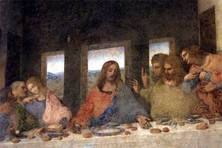 Today, a guest post from friend-of-Beliefnet Erin O’Donnell (check out her migraine control tips and nutrition quiz!). Erin spotted this juicy news item about what researchers are learning about the history of portion sizes by looking at paintings of the Last Supper. Fascinating food (har, har) for thought….
Today, a guest post from friend-of-Beliefnet Erin O’Donnell (check out her migraine control tips and nutrition quiz!). Erin spotted this juicy news item about what researchers are learning about the history of portion sizes by looking at paintings of the Last Supper. Fascinating food (har, har) for thought….
The Last Supper: Portion Distortion?
By Erin O’Donnell
You’ve heard of asking WWJD, or “what would Jesus do?” An
interesting new study in the International Journal of Obesity asks WWJE–What would Jesus eat?–or more specifically, How much would he eat?
Apparently we moderns aren’t the only ones coping with ballooning portion sizes.
Researchers looked at 52 different paintings of the Last Supper created over the course of 1000 years and measured the size of the meals depicted in the paintings. They found that over time, artists gradually heaped more on Jesus’ plate. Main courses grew
by 69 percent, plate size by 66 percent, and bread size by 23 percent.
Brian Wansink, Ph.D., of the Cornell Food and Brand Lab, say these new findings suggest that the urge to supersize isn’t a new phenomenon. It’s been slowly building over a millennium.
Wansink, author of Mindless Eating: Why We Eat More than We Think, has conducted some fascinating (and depressing!) studies on portion size, showing that factors like over-sized plates and portions give our brains cues that make us eat too much.
But he says there are simple ways to counteract “portion distortion.” For example, he suggests eating from a smaller plate at mealtimes, avoiding massive spoons, and giving your family members snacks like chips in small baggies or containers. (Hiding the big bags can help limit intake.)
(image via: http://www.italianfrescoes.com/)
Like
what you see? Click here to subscribe
and get Fresh Living in your in-box every day.
